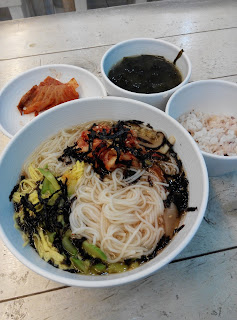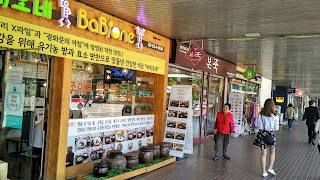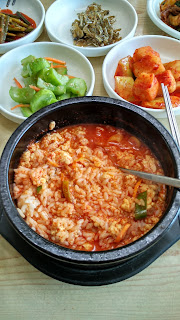Vegetarian food is not common in Korea. Even in a big city like Seoul, the number of vegetarian establishments is quite limited.
If you are visiting Seoul, my recommendation is to stay in Insadong area or nearby (e.g. Jongno3 area). It is quite a nice neighbourhood, full of galleries and restaurants. It is also quite centrally located and is near the major sights such as the Cheonggyecheon stream, the Imperial Palaces and Buchon. Transport is also very convenient -- it is served by a few airport buses and 3 subway lines. But most importantly, it has the most vegetarian options in Seoul, and including a few of the most popular ones.
This is a map of the vegetarian options. For exact address, opening hours and reviews, check the Happy Cow website.
1. Oh Se Gae Hyang (五色根香)
This restaurant is one of the most popular restaurant serving vegetarian Korean food, and is my favourite. It is run by the religious group that also runs the Loving Hut chain of restaurants. If you want to try the traditional Korean food, this is the place. You can find classic dishes such as Soft tofu stew (sundubu jiggae), bibimbap, jajang noodles. There are also a few western options such as mock meat cutlet. The price is moderate - most mains at 8000 won.
Note: they close quite early. Last order at 8:30pm, but you should try to get there before 8pm. Check out their menu here: http://www.go5.co.kr
 |
| We ordered a mushroom dish, sesame soup and a soy protein stew. Meal came with free tea and 5 side dishes. The side dishes are pretty good. I particularly like the lotus root. |
 |
| This mushroom dish looks like dried oysters. Quite tasty and chewy. |
2. Han Gwa Chae (韩果菜)
The name of the restaurant literally means Korean Fruits and Vegetarians. This is a Korean buffet. The food is mostly Korean Temple Food. There is quite a distinctive taste to Korean Temple Food, mostly due to how they preserve some vegetables. I can't say I really like it, but I didn't find it objectional either. However, there is quite a variety here. The food is quite healthy - there is multi-grain sesame porridge, brown rice and multi-grain purple rice. There was quite a variety when I was there - glass noodles, bean sprouts, various greens, mushrooms, tofu, chilli peppers etc. The most unusual was peanut sprouts! That was the first time I seen it! It's like a giant bean sprout. But the dish that I like most was the chives pancake that the owner made for us. The buffet is really a bargain at 13,000 won per person! It closes really early for dinner -- get there before 7:30pm. The first time I arrive at 8pm and they were closing already.
 |
| A bit of everything for my first round at the Han Gwa Chae buffet |
 |
| Pancake hot from the pan -- it was good. Bottom left - wild vegetable stew. Bottom right - sesame porridge |
 |
| The spread at Han Gwa Chae |
3. Bibigo Gyejeol Bapsang (비비고 계절밥상), Season’s Table
This is not a vegetarian restaurant. But it is a very vegetarian friendly Korean Buffet restaurant. Located inside the Insadong Maru building, it is one of the chain restaurants run by Bibigo (which is owned by the CJ conglomerate). This is a great place for a meal if you are travelling with non-vegetarian friends.
As part of the buffet, there are cook-to-order food like kimchi stews and hotstone bibimbap. You can also make your own cold bibimbap - just choose the vegetables. There is a salad bar, freshly squeezed juices, fruits and ice cream. I love the garlic fried rice. Other vegetarian options are tempura pumkin, vegetables fritters, steamed buns, pancakes -- more than enough to fill your stomach!
For a buffet like this, I find it pretty inexpensive. Weekday lunch cost only 14,900 won, while dinners and weekend lunch cost 22,900 won! I won't be able to get such good deals in Singapore!
This restaurant is not listed in Happy Cow, but it is very easy to find as it is in the Insadong Maru Building. I read on the internet that there is always a long queue on weekends. I was there on a rainy Sunday and it was quite empty.
 |
| Top left, a small bowl of make-your-own bibimbap. Big plate - pumpkin tempura, salad and vegetable fritters. |
 |
| Another round - fried egg, grilled corn, garlic fried rice, grilled onion, pumpkin tempura, vegetable fritters, vegetable pancake wedge |
 |
| Three deserts, all good - pancake with sunflower seeds, ice ripen persimmons, steamed buns with red bean paste. The glass of green juice is delicious fresh blend of kiwi and kale. |
4. Cafe Insarang
This cafe is located right along the Insadong street. I saw a sign that said Vegan Food & Tea. I didn't eat there, so I can't comment. Check the listing in Happy Cow.
5. Jogyesa Temple
I am told that the temple serves lunch to the public for 1000 won. I had a friend who visited it and had lunch at the temple. I know the big temples do serve lunch to the public for free or a small fee. However, I do not know where the temple cafeteria. You may want to look out for it if you are there. Typically, lunch will be served from 11:30am - 12:30pm.
(Similarly, I found a guide book that says the big temple Bongeunsa near COEX serves lunch for a very small fee. But I am not where the cafeteria is.)
6. Jogyesa Kitchen
This is a cafeteria that is run by the Jogyesa temple. It is located in a small lane next to the temple and can be difficult to find. You first need to buy a voucher for 4000 won from the temple's souvenir shop. Then you hand over the voucher and order your mains from a limited menu of 4 noodles and 3 rice. On top of your main order, there is free flow of white rice, seaweed soup, kimchi which you can self-serve. I ate here twice on my first trip and really love the cold bibim noodles (bibimguksu). The soft noodles in broth (janchi guksu) is also not bad. At 4000won, it is probably one of the cheapest meal you can have in Seoul.
 |
| The Jogyesa kitchen, found in a small lane next to the temple |
 |
| Janchi Guksu, soft noodles in a light broth |
 |
| My favorite at Jogyesa Kitchen - Bibim Guksu (cold noodles in spicy sauce). Complimentary kimchi - cabbage and persimons kimchi! (I don't like them though) |
7. Baru
There are actually two Baru restaurants in the Jogyesa Temple Stay Building. One is a buffet restaurant, the other is a fine dining restaurant that requires reservation. Both serve temple food. I did not try either of the restaurants. They are listed in Happy Cow
8. Bonjuk
This is not a vegetarian restaurant. It is a chain and there are many location. One of them is right along Insadong street, up on the 2nd floor overlooking the walking street. It serves mostly porridge and a few bibimbap. The rice porridge are mostly cooked with meat or seafood. There is a vegetable porridge which I had. There is no meat in it, but I suspect it may be flavored with some meat stock.
To be on the really safe side, you can order the non-rice porridge, such as pine nut, sesame, pumpkin and dates. My friend and I ordered a pine nut porridge to share. It was a huge bowl of blended pine nut. It had a nice pine nut aroma, but otherwise rather blend. It is thick and rich and very filling. We couldn't finish it.
With so many vegetarian options, you don't really need to eat here. But what is good is that it opens pretty early and is a good breakfast option if you do not want to eat bread. (My hotel did not serve breakfast)
Street Snacks
There are quite a number of street snacks along the Insadong street at night. Some of them are vegetarian. The Goldfish biscuit is my favourite!
 |
| My favourite street food - goldfish biscuit. It's a crispy crust with sweet red bean paste filling. |
Other convenient restaurants
There are 2 other restaurants that can be reached conveniently by taking the subway from the Anguk station.
9. Jeoksubang (滴水坊)
This is a restaurant located within the Taiwan Fo Guang Shan Buddhist Monastery. It is very near the Dongguk university subway station (exit 2).
The food here is Taiwanese. As it is run by the monastery, they serve strict Chinese Buddhist vegetarian -- i.e. no garlic, onion, leeks or chives, and no eggs. There may be some dairy products.
Unlike the Chinese Buddhists, Korean temple food do not avoid the allium family of vegetables. So for those who do not take onion & garlic, this is an important restaurant for your meals.
They serve an inexpensive buffet lunch. The dishes were mostly home-cooked food, but very hearty and tasty. I loved it. I came here twice. They also had a menu you can order from. Their pot stickers is really good.
The door to the temple building is always closed -- just push through it. The restaurant is in the basement. Restaurant is closed on Sundays.
 |
| Pot stickers - each has a very crispy side and very generous filling |
 |
| Buffet lunch -- mostly home cooked dishes. The soup was really delicious and I went for a few rounds. |
10. Babione
Located at the Express Bus Terminal, this is an convenient restaurant if you are in the Gangnam area or you are taking buses from here to further afield.
In fact I choose to take buses from the Express Bus Terminal instead of the Dong Seoul Intercity Bus Terminal, because there is a vegetarian restaurant here!
This restaurants serves Korean stews and bibimbaps. Prices are inexpensive as most mains start at 8000won.
It is located on the ground floor of the Terminal building, but facing out of the building instead of the bus waiting area. Look for it near bus bay 26.
 |
| English menu is available |
 |
| I ordered the Tofu stew, thinking it's going to be a spicy tofu jiggae. It turned out to be a wild vegetable tofu stew (8000won). The big plate of mushroom with glass noodles (15,000won) |
With the number of choices within the small area, vegetarians will find it convenient to stay around Insadong.
If you are looking for a budget accommodation, I would highly recommend Saerim Hotel which is just behind the Insadong Maru building. The rooms are small and basic, but clean and good value for money. If you are okay sleeping on mattress instead of bed, get the traditional Korean room -- it won't feel so cramp.
If you want nicer hotels, there are several in the Jongno 3 area closer to the Cheonggyecheon stream, but still within walking distance to Insadong.




















